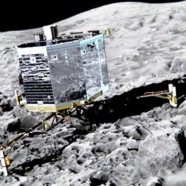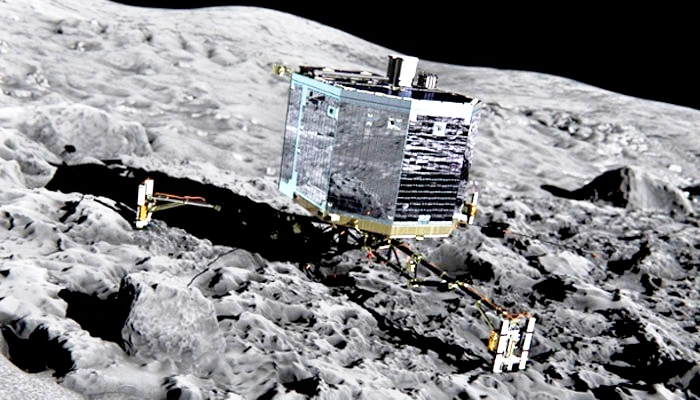Robot Landed on Comet
For the First Time, Humanity Has Landed Something on a Moving Comet.
The comet probe Philae may have bounced when it landed, the European Space Agency (ESA) said Wednesday.
It is the first time a soft landing has been achieved on a comet — but there was a hitch.
Comet 67P has a very weak gravity, so anchoring harpoons were designed to shoot into the comet to fix the spacecraft to the surface. They failed to fire and Philae is not firmly secure, ESA says.
Philae lander manager Stephan Ulamec said the probe may have lifted off again and turned.
“So maybe we didn’t land once — we landed twice,” he told a news conference.
“Did we land in a soft sand box or is there something else happening? We don’t fully understand what happened,” he said.
Ulamec said scientists remain upbeat as they are still receiving data from the spacecraft and they hope to learn more Thursday.
Shortly after landing was confirmed, the probe tweeted: “Touchdown! My new address: 67P!” Later, it tweeted again: “I’m on the surface but my harpoons did not fire.”
Led by ESA with a consortium of partners including NASA, scientists on the Rosetta comet-chasing mission hope to learn more about the composition of comets and how they interact with the solar wind — high energy particles blasted into space by the sun.
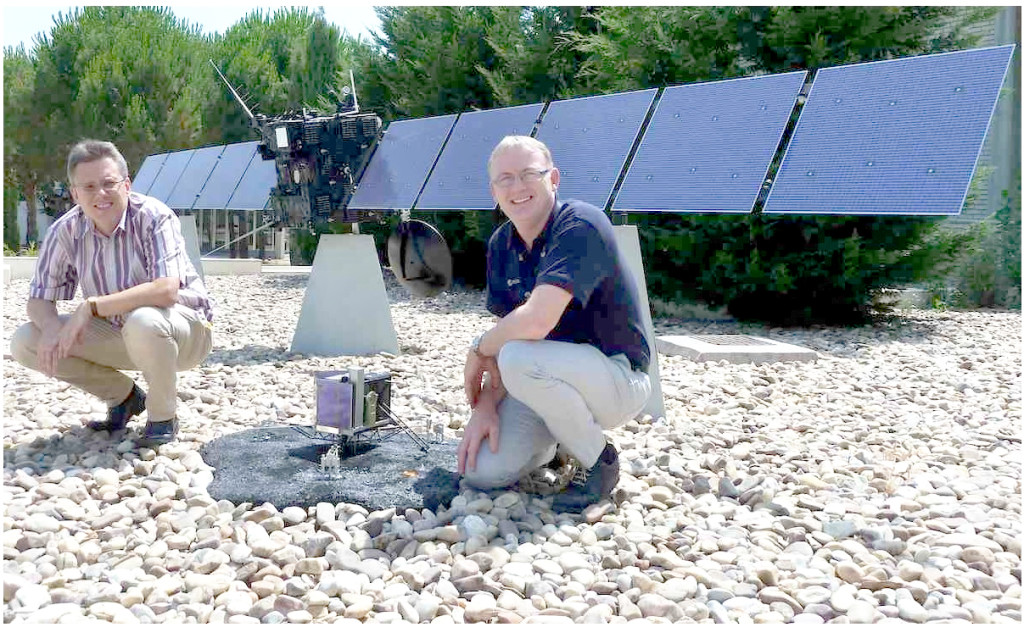
Michael Küppers (left) and Laurence O’Rourke (right) with a 1:4 scale model of Rosetta and Philae at ESAC. (Credit: ESA)
Speaking to CNN shortly after the landing, ESA lander system engineer Laurence O’Rourke said they were trying to check the orientation of the craft, to see “how we landed and where we landed.”
“We are extremely happy,” he said. “To get the signal it had touched the surface was a major achievement — it was quite extraordinary. Philae is already taking measurements, sniffing the comet.”
He also said the probe could start drilling into the surface and analyzing the material as soon as Thursday.
The comet is currently 500 million kilometers (310 million miles) from Earth and pictures from the Rosetta mission to track it on its orbit around the sun have amazed scientists.

Comet 67P/Churyumov-Gerasimenko’s dimensions, as measured from images taken by Rosetta’s OSIRIS imaging system. The images shown in the graphic were taken by Rosetta’s navigation camera on 19 August. The larger lobe of the comet measures 4.1 x 3.2 x 1.3 km, while the smaller lobe is 2.5 x 2.5 x 2.0 km. More details via the blog: Measuring Comet 67P/C-G (Credits: Image: ESA/Rosetta/NAVCAM; Dimensions: ESA/Rosetta/MPS for OSIRIS Team MPS/UPD/LAM/IAA/SSO/INTA/UPM/DASP/IDA)
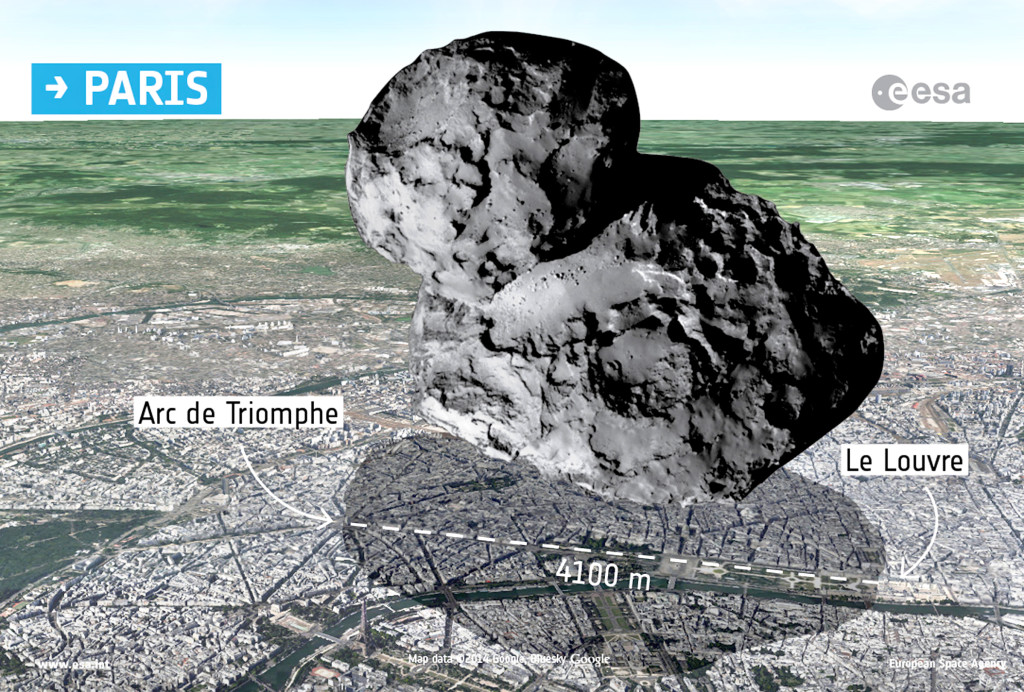
Photo illustration provided by the European Space Agency (ESA) the 67P/Churyumov-Gerasimenko comet is shown to scale in comparison to the city of Paris. (Photo by ESA)
NASA’s chief scientist, Ellen Stofan, told CNN: “That comet is the most bizarre, wonderful thing I have ever seen. Those images have just blown me away. Philae was such a huge success before it even did anything, so kudos to ESA and the scientific community.
“No one has ever gotten data like Rosetta has gotten. No one has ever been able to land on a comet the way Philae just did.”
Astronomer Robert Massey also called the landing a tremendous achievement.
“A comet is a bit like a time capsule, which is why it’s special,” he told CNN.
“It’s an insight into the composition of the early solar system — the ratio of chemicals.
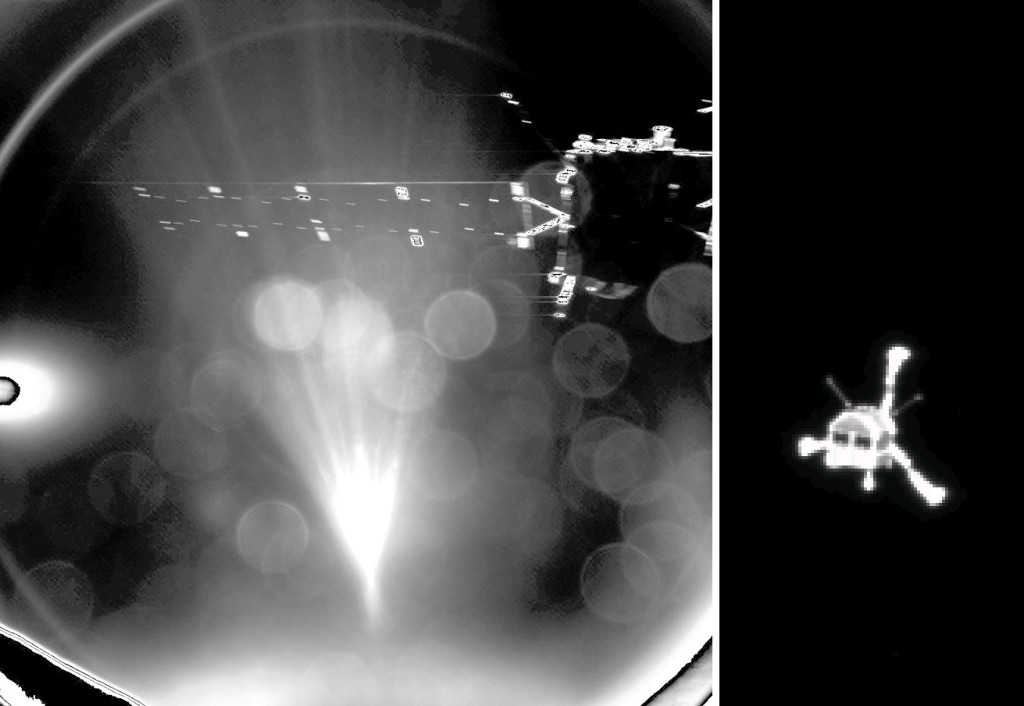
Left: Photo from Philae lander just after separation from its mother ship Rosetta (top right). Right: Photo of Philae taken from mothership Rosetta after separation. (Credit: ESA)
“Even without Philae, we still have Rosetta in orbit around a comet, giving the ability to watch it at close quarters. There will be a lot of science from this,” he said.
Weighing in at 220 pounds, it might be the size of a domestic washing machine but Philae is considerably smarter.
It is equipped with an array of experiments to photograph and test the surface of Comet 67P as well as finding out what happens when the roasting effect of the sun drives off gas and dust.
Built by a European consortium, led by the German Aerospace Research Institute (DLR), the landing probe has nine experiments.
According to details on ESA’s Rosetta website, sensors on the lander will measure the density and thermal properties of the surface, gas analyzers will help to detect and identify any complex organic chemicals that might be present, while other tests will measure the magnetic field and interaction between the comet and solar wind.
Philae also carries a drill that can drive 20 centimeters (8 inches) into the comet and deliver material to its on-board ovens for testing.
Scientists are already pleased with progress of the mission.
ESA project scientist Matt Taylor said: “The orbiter will remain alongside the comet for over a year, watching it grow in activity as it approaches the sun, getting to within 180 million kilometers (112 million miles) in summer next year, when the comet will be expelling hundreds of kilograms of material every second.

Newly released images taken from just 6 miles above the comet show high plateaus sticking up from its boulder-strewn surface. (Credit: ESA)
“It’s got an awesome profile — the adventure of the decade-long journey necessary to capture its prey, flying past the Earth, Mars and two asteroids on the way,” he said.
Daniel Brown, an astronomy expert at Nottingham Trent University in the UK, said: “Although we have landed on planets, moons and asteroids, it has never been attempted for a nucleus of a comet — and with good reason. These objects have a very low gravity, are loosely composed of ice, dust and rocks, and are very irregular in shape. They are temperamental in their behavior and notoriously difficult to predict.
“Comets such as 67P have already been exposed to the intense heat of the sun in their past orbits, resulting in their surface being altered, but going beneath the surface will give us an insight into unchanged material, allowing us to peak into the chemical composition of our early solar system.
“Apart from the amazing scientific results, the sheer challenge and ambition of such a mission is outstanding and illustrates how our space exploration of the solar system has become more advanced and successful. It gives us much to hope for in future missions.”
And science fiction writer Alastair Reynolds said: “This is science fiction made real in terms of the achievement of the mission itself, but Rosetta is also taking us a step closer to answering science fiction’s grandest question of all: Are we alone?”
Source: Dave Gilbert / CNN
========================
How to Land on a Comet
We Landed Twice
Robot Landing on Moving Comet
Could Rosetta Unlock Earth’s Secrets?
========================
Mysterious’ song of Rosetta’s comet
Rosetta’s Plasma Consortium (RPC) has uncovered a mysterious ‘song’ that Comet 67P/Churyumov-Gerasimenko is singing into space. RPC principal investigator Karl-Heinz Glaßmeier, head of Space Physics and Space Sensorics at the Technische Universität Braunschweig, Germany, tells us more.
RPC consists of five instruments on the Rosetta orbiter that provide a wide variety of complementary information about the plasma environment surrounding Comet 67P/C-G.
(Reminder: Plasma is the fourth state of matter, an electrically conductive gas that can carry magnetic fields and electrical currents.)
The instruments are designed to study a number of phenomena, including: the interaction of 67P/C-G with the solar wind, a continuous stream of plasma emitted by the Sun; changes of activity on the comet; the structure and dynamics of the comet’s tenuous plasma ‘atmosphere’, known as the coma; and the physical properties of the cometary nucleus and surface.
But one observation has taken the RPC scientists somewhat by surprise. The comet seems to be emitting a ‘song’ in the form of oscillations in the magnetic field in the comet’s environment. It is being sung at 40-50 millihertz, far below human hearing, which typically picks up sound between 20 Hz and 20 kHz. To make the music audible to the human ear, the frequencies have been increased by a factor of about 10,000.
The music was heard clearly by the magnetometer experiment (RPC-Mag) for the first time in August, when Rosetta drew to within 100 km of 67P/C-G. The scientists think it must be produced in some way by the activity of the comet, as it releases neutral particles into space where they become electrically charged due to a process called ionisation. But the precise physical mechanism behind the oscillations remains a mystery.
“This is exciting because it is completely new to us. We did not expect this and we are still working to understand the physics of what is happening,” says Karl-Heinz.
RPC may also be able to help in tracking Philae’s descent to the surface of 67P/C-G on 12 November, in tandem with the lander’s on-board magnetometer, ROMAP .
The contributing institutions to these instruments are:
RPC: Institutet för rymdfysik (IRF), Uppsala, Sweden; Southwest Research Institute (SwRI), USA; Institut für Geophysik und Extraterrestrische Physik, Technische Universität Braunschweig, Germany; Laboratoire de physique et chimie de l’environnement et de l’espace (LPC2E), Université d’Orléans, France, and Imperial College London, United Kingdom.
RPC-Mag: Institut für Geophysik und Extraterrestrische Physik, Technische Universität Braunschweig, Germany; Imperial College London, United Kingdom; Space Research Institute Graz, Austria
Source: Claudia / Rosetta Blog at blog.ESA.int

